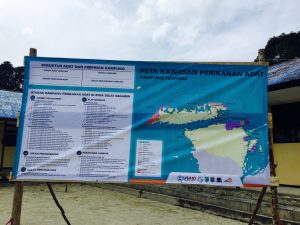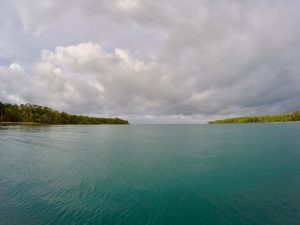Last night I returned from a whirlwind adventure…I mean a week of field work…with Rare Indonesia in Raja Ampat, West Papua, Indonesia. Over the course of the past 8 days, I traveled on 4 planes, 5 boats, visited 2 cities, and 3 villages, met countless insightful and passionate local villagers and learned invaluable information about the Dampier Strait MPA system.
Our trip to West Papua had three objectives. First, we were to conduct reef health assessments for four sites to determine the state of a portion of the reefs in Dampier Strait. Second, to celebrate the customary declaration, and the last goal was to interview village members and government officials on enforcement and patrol of the MPA.
I will start from the top- the beginning of our journey to Kalwal Village, Salawati Island. Kalwal Village is situated on the western corner of Salawati, just outside the boundary of the Dampier Strait MPA. Not long ago the villagers of Kalwal lived in another village slightly north, called Kaliam, but in the past 4 years migrated south to declare land of their own. While Kaliam is set inside the MPA boundary, Kalwal is not, although they would like to be. So, we came to do just that, to sign revisions to the original MPA declaration to shift the boundary westward.
We came bearing gifts, a basket of cigarettes, and pinang (or betel nut) for the village men to enjoy while they discussed the future changes to the MPA. The meeting lasted about four hours, and I sat on the floor nodding and smiling occasionally, pretending like I had some clue what was being discussed. Occasionally I caught a word here or there, “bomb” I guess does not translate into their local language of Bahasa. Also, they were not shy to point at me when they were curious why this foreigner, and only female, was eavesdropping on their quite serious conversation. At the end of the day the papers were signed, and the boundary will shift… in due time.
The following day we set out to conduct reef and fish assessments. Our first dive was by far the worst conditions of diving I have experienced to date in my nine years underwater. Unfortunately, we aborted the remaining dives and I was left to dream up what the reefs in Raja Ampat look like. Note to self…travel to Raja Ampat any time other than monsoon season, which happens to begin in July. Although I did not get to go diving like I had hoped, it was still a really great learning experience to see the coordination and logistics that go into planning work dives.
Part two- the customary declaration. When the staff from Rare first told me we would be going to a “customary declaration” I honestly had no idea what that meant, but I was definitely looking forward to the event as I knew this was a big deal! I later learned that the customary declaration on July 10, 2018, was a significant day in the history of the Dampier Strait marine protected area, as it would be the day that the administrative boundaries of the MPA overlaid with the customary boundaries of the villagers. Now for a little bit of history… land and sea tenure, or territorial rights, in West Papua is not written into formal law, rather passed on verbally from one generation to another with resource rights vested in individuals, families, clans, or entire communities. Village governments, adat institutions (adat means customary), and religious institutions are the key stakeholders to legitimize marine tenurial systems. Understanding the complex system of stakeholders took me weeks of reading hundreds of pages of literature to wrap my head around, so if you are confused reading this…I certainly understand as I am still figuring out all the details myself as well. Anyway, with that said, customary boundaries proved to be extremely important to the villagers, so the move to overlay the current MPA system boundaries with their customary fishing and tenurial boundaries was a huge move! Rare Indonesia and USAID worked with the individual villages using focus group discussions to create maps of village marine boundaries, which were additionally confirmed through resource use monitoring. After months of research and planning the Kawasan Perikanan Adat, or Customary Fisheries Area, were declared. There was a huge party in Yenanas village, the second village I visited on my Raja Ampat tour, to welcome these changes. Hundreds of locals gathered to watch as the 57 village leaders (3 per village- one village leader, adat leader, and religious leader per village) to sign the declaration. Traditional dancers, customary ceremony, and a large feast set the scene for the celebration of this monumental day. Unfortunately, I arrived at the tail end of the declaration as the team I was with tried to give diving conditions a second shot, but at the end of the day, it was incredible to see that many people gathered together to express their environmental stewardship.

Declaration signatures
While most of the Rare team and visitors set sail from Yenanas village, myself and one staff member made our way to Yensawai village to conduct interviews regarding enforcement of the MPA. As we neared land from our small speedboat I was blown away, were these over the water bungalows I see?? I could not contain my excitement! Katherine from Rare told me we would be staying in a homestay, but these beautiful Bora Bora like bungalows were not what I was expecting! I was thrilled, to say the least. To set the scene, my previous nights in the other two villages were quite different as we were welcomed into family homes and I lived like the locals did- slept on the floor without a mosquito net, in homes that were not equipped with electricity nor running water. Remember when I mentioned Spartan conditions in my last post? The conditions were Spartan all right! But for my last night, I was given the pleasure of being the first guest in a new economic initiative, the Mande Mor Yensawi Homestay and enjoyed my own space as the waves sung me to sleep below.
That night we walked around the village and met with several leaders to discuss their patrolling and enforcement activity. I sat aside Katherine while she asked the questions I prepared and continued smiling and nodding at the discussion- by now I was getting good at this! Over a dinner of freshly caught fish on the porch of our bungalow Katherine shared the results from her discussions with the community members. The objectives of my questions were to determine 1) what kind of enforcement exists now, 2) what are the limitations to conducting enforcement of the MPA, 3) what costs and capacity are needed to enhance enforcement, and 4) how can a conservation agreement be made to boost ecological activity that would at the same time reap the economic benefits? To put it simply, the villagers of Yensawi are lacking the capacity to conduct enforcement and need additional financial resources, and this is where OneReef has the potential to step in. The government conservation agency currently conducts two patrols per week, but this is not enough to protect the MPA from illegal activity. Community-based patrol is crucial in the safekeeping of their vulnerable reefs but it all comes down to the lack of capacity to do just that. The issues are what one would expect, the lack of funds to purchase fuel, no salary for those on patrol, and limited facilitators for education and training for enforcement activity. Learning this information from the village leaders, and again the next day at the government office in Waisai, the capital of Raja Ampat, was extremely beneficial and was the exact resources I need to move forward with determining the ideal economic model to enhance enforcement in the MPA.
Now as I settle back into life in the bustling city of Bali I will decompress and spend the rest of my time creating a report to determine how OneReef can best help the MPA through financial resources and capacity building. My next post will focus on what I have come up with, so get ready for the big reveal!
And before I wrap up I wanted to end with a quick anecdote. Like I said, all of the many meetings I attended were spoken in the local language, and it was almost expected that the villagers did not speak a lick of English. It was not until we shook hands and said terima kasi, or thank you, at the end of a meeting that one of the villagers spoke up. He said “the ocean is our mattress, the waves are our pillow, and the wind is our blanket. That is what we say in Yensawi.”











